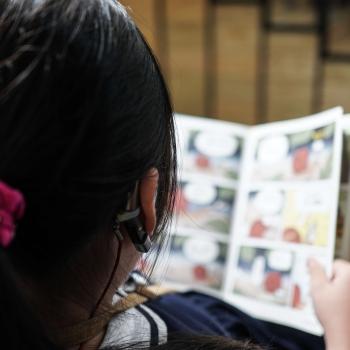Comics in the Classroom as an Introduction to Genre Study

- Preview |
- Standards |
- Resources & Preparation |
- Instructional Plan |
- Related Resources |
- Comments
Overview
This lesson capitalizes on the popular appeal of comics by using them to introduce the concept of genre. Students begin by working in small groups to analyze differences and similarities among a selection of comics from a variety of subgenres. Based on their discussion, they determine what subgenres are represented and divide the comics accordingly. They then analyze the professional comics' uses of conventions such as layout and page design. Finally, they create their own comics using an online tool.
Featured Resources
Comic Creator: Students use this online tool to create their own comics.
From Theory to Practice
Recently emerging as a genre "worth" studying in school, comics can act as a springboard for genre study as well as tap higher-order thinking skills. Versaci (2001) points out that "[A]side from engagement, comic books also help to develop much needed analytical and critical thinking skills. A common goal, regardless of the level we teach, is to help students read beyond the page in order to ask and answer deeper questions that the given work suggests about art, life, and the intersection of the two. Comic books facilitate this . . ." (64).
Further Reading
Common Core Standards
This resource has been aligned to the Common Core State Standards for states in which they have been adopted. If a state does not appear in the drop-down, CCSS alignments are forthcoming.
State Standards
This lesson has been aligned to standards in the following states. If a state does not appear in the drop-down, standard alignments are not currently available for that state.
NCTE/IRA National Standards for the English Language Arts
- 1. Students read a wide range of print and nonprint texts to build an understanding of texts, of themselves, and of the cultures of the United States and the world; to acquire new information; to respond to the needs and demands of society and the workplace; and for personal fulfillment. Among these texts are fiction and nonfiction, classic and contemporary works.
- 2. Students read a wide range of literature from many periods in many genres to build an understanding of the many dimensions (e.g., philosophical, ethical, aesthetic) of human experience.
- 3. Students apply a wide range of strategies to comprehend, interpret, evaluate, and appreciate texts. They draw on their prior experience, their interactions with other readers and writers, their knowledge of word meaning and of other texts, their word identification strategies, and their understanding of textual features (e.g., sound-letter correspondence, sentence structure, context, graphics).
- 4. Students adjust their use of spoken, written, and visual language (e.g., conventions, style, vocabulary) to communicate effectively with a variety of audiences and for different purposes.
- 8. Students use a variety of technological and information resources (e.g., libraries, databases, computer networks, video) to gather and synthesize information and to create and communicate knowledge.
- 11. Students participate as knowledgeable, reflective, creative, and critical members of a variety of literacy communities.
- 12. Students use spoken, written, and visual language to accomplish their own purposes (e.g., for learning, enjoyment, persuasion, and the exchange of information).
Materials and Technology
- Access to the Internet
- Overhead or LCD projector
- Examples of comics
Websites
Student Objectives
Students will
- explore a variety of comic strips.
- discuss components of comic strips.
- examine conventions of comic strips.
- analyze online Comic Creator interactive and create a planning sheet for using the tool.
- apply what they have learned about comics by creating one of their own.
Instruction and Activities
- Begin by brainstorming with the students the names of different comics that they know. Also have the students give descriptions about them.
- Pass out samples of many different types of comics and comic books. Be sure to include historical, political, Illustrated Classics, "funnies," superheroes, and examples from contemporary books such as Spiegelman's Maus.
- In small groups, students should discuss what is similar and different among the types of comics.
- Is there dialogue? How is it presented?
- What are the characters doing? How is that shown?
- What is the shape of the comic frames? What does that represent?
- How is action shown?
- What happens from one frame to the next?
- Is there dialogue? How is it presented?
- Using the information from their discussions, have the students come up with the different comic subgenres such as those noted in #2 above. The students should realize that within comics there are many genres and sometimes genre determines convention.
- Present the following information to the students:
- Comics manipulate space on a page to guide the reader and affect the interpretation of the story.
- Page layout and design can represent different organizational models, especially for storytelling. For example, a page with many frames can represent an ongoing scene with a lot of action. Larger frames with a great deal of detail may be an artist's attempt to set a forthcoming scene. Even page divisions add a certain element of story organization.
- Comic "storytellers" are careful not to include too many disjointed scenes on one page; as with a written narrative, such a mixture would make for a confusing and jumbled story.
- Layout is important when combining images and text, and with comics, students can transfer knowledge of visual organization to verbal and written organizational models.
- The concept of exploring one idea fully before moving onto the next could be likened to the page-break concept in graphic art.
- Comics manipulate space on a page to guide the reader and affect the interpretation of the story.
- With the new information they have, students should observe the conventions of page design and layout. Then they should analyze professional comics' use of the conventions.
- Using an LCD projector, demonstrate the Comic Creator student interactive and all of its tools. The students can use their knowledge of comic components and conventions to guide the teacher through a whole-class created comic.
- Finally, using the Comic Creator on their own, students experiment with the conventions of page design and layout in their own comics.
Extensions
- As a writing activity, the students in small groups can create a planning or tips sheet that can be given to Comic Creator users. This sheet would help them make decisions about creating their own comic strip. The creation of this tips sheet is also the assessment that determines how much the students understand from the first session of the lesson.
- If you want to continue using comics in your classroom, visit the National Association of Comics Arts Educators for additional lesson plan, activities, and other resources.
Student Assessment / Reflections
As this lesson is the introduction to a longer unit on comics and genre study, teacher observation and conferences and interviews should make up the bulk of the assessment to ensure that students are grasping and retaining the material as they move through the unit. Participation in guided discussion should also be considered.
If grades are to be given, teachers can assess the creation of the comic strip as well as the tips sheet if they chose to do the extension activity.

Add new comment